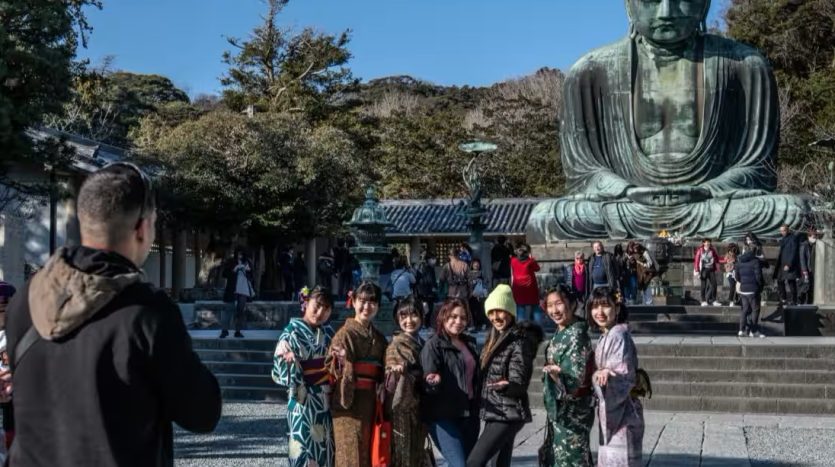[NIKKEI Asia] From Kyoto to Kamakura, Japan braces for new surge in overtourism
From Kyoto to Kamakura, Japan braces for new surge in overtourism
Coping strategies include free transfers to subway and limits on Mount Fuji climbers
Tourists pose in front of the Great Buddha statue in Kamakura. The city is readying for an influx of tourists during Japan’s Golden Week vacation season.
TOKYO — Major tourist destinations in Japan have been scrambling to prepare for the strain that visitors will put on public transit systems during the upcoming Golden Week holidays, the first since major pandemic restrictions were lifted.
Packed city buses have become a constant in Kyoto. So from April 27 to May 6, the city is calling on riders to make free transfers from the buses to the city-run subway system via special tickets. A rider will need only pay the 230 yen ($1.46) bus fare to take advantage of the service.
In particular, the free subway program aims to decrease the crowding on buses connecting the Kinkakuji temple to Kyoto Station. The route runs through the center of town, and ridership is high even among Kyoto residents alone.
The addition of tourists — many with bulky luggage in tow — has led to a critical overcrowding of buses.
For Golden Week, Kyoto is also increasing the frequency of buses connecting Kyoto Station to the Kiyomizudera temple. Buses will make arrivals every three to four minutes. Direct-service buses will launch in June.
To further ease crowding, there will be higher frequencies of buses serving other tourist destinations in Kyoto, such as the Heian-jingu Shrine.
Kyoto has also put in place monitors at Kyoto Station show live footage of the tourist spots for visitors. The video feeds can be accessed online as well. The idea is to show tourists which areas are less crowded so that they can plan their trips accordingly.
Kamakura, another temple city, has been experiencing a large influx of tourists because it is easily accessible from Tokyo. Crowds of international visitors have milled in front of stations, obstructing foot traffic.
Since mid-April, Kamakura has deployed English-speaking volunteers to the stations to guide tourists to where they need to be and ease congestion. The guides have been posted at the stations on weekends and holidays so far but will now also be deployed on weekdays during Golden Week.
Since 2023, Kamakura has been discussing how to control overtourism during Golden Week with the neighboring city of Fujisawa, with the central government and with local transport operators.
Enoshima Electric Railway, which operates a popular old-fashioned train to local tourism destinations, plans to run a “social experiment” between May 3 and May 5 to help out locals amid the Golden Week crowding. If the line to board extends beyond Kamakura Station, customers who present proof that they live along the rail line will be allowed to enter the station without needing to wait outside.
In a bid to spread tourists out and alleviate traffic, Kamakura has set up park-and-ride locations where travelers can park their cars and take public transit to their destination. These sites include parking for the Enoshima Electric Railway train. As a sweetener, the city will offer discounts and other perks from participating stores and temples to park-and-ride users.
Mount Fuji, where the climbing season begins in July, will restrict the number of climbers. Yamanashi prefecture will install a gate at a common starting point midway up the mountain on the most popular climbing route and limit the number of people who can pass through to 4,000 per day.
A toll of 2,000 yen per person will also be required to pass through the gate, on top of the 1,000 yen voluntary contribution now asked of climbers. Gates will be closed from 4 p.m. to 3 a.m.
Shizuoka prefecture does not collect tolls on the routes on its side of Mount Fuji. But to prevent people from climbing rapidly to the summit to watch the sunrise without staying in a mountain lodge, it will start a trial where it places staff near trails and restricts people from entering after 4 p.m.
Kyoto, Kamakura and Mount Fuji are all leading Japanese tourist destinations that have accumulated know-how in dealing with large numbers of foreign tourists.
As more tourists flock to Japan to take advantage of the weak yen this summer, other destinations may need to follow suit to strike a balance with locals’ daily lives.
Original source: NIKKEI Asia “From Kyoto to Kamakura, Japan braces for new surge in overtourism“

